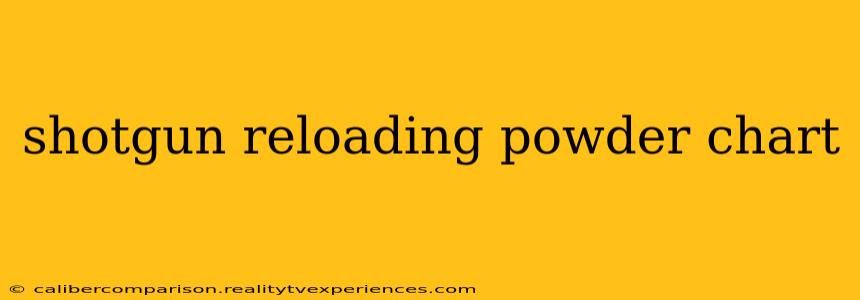Reloading your own shotgun shells can be a rewarding experience, offering cost savings and the ability to tailor your ammunition to specific needs. However, safety is paramount, and understanding shotgun reloading powder charts is crucial. This guide provides a detailed overview, focusing on safe practices and effective chart interpretation. Remember, always consult the specific powder manufacturer's data sheet before reloading. This information is for educational purposes only and does not substitute for the manufacturer's instructions.
Understanding Shotgun Reloading Powder Charts
Shotgun reloading powder charts are essential tools for safe and accurate reloading. These charts provide crucial information regarding the correct powder charge weight for specific shotgun shells, shot sizes, and hull types. They are typically organized by powder type, allowing you to quickly find the recommended data for your chosen components.
A typical chart will include the following information:
- Powder Manufacturer and Powder Type: Clearly identifies the brand and type of powder. Using the wrong powder is extremely dangerous.
- Hull Type and Manufacturer: Specifies the type of shotgun hull (e.g., Remington Gun Club, Winchester AA) Different hulls have varying capacities, impacting the correct powder charge.
- Shot Size and Weight: Indicates the size and weight of the shot being used (e.g., #8 shot, 1 1/8 oz). Shot weight significantly influences pressure.
- Wad Type: Identifies the specific wad being used. Wads play a crucial role in pressure regulation and shot pattern.
- Powder Charge Weight (in grains): This is the most critical piece of information—the precise amount of powder to use. Improper powder charges can lead to catastrophic equipment failure or injury.
- Pressure (PSI): Indicates the pressure generated within the shell upon firing. This should remain within the safe operating pressure limits for your shotgun.
- Velocity (fps): Shows the muzzle velocity of the shot.
Deciphering and Using the Chart
-
Identify Your Components: Before you begin, meticulously identify all components: the powder type, hull manufacturer and model, wad type, and shot size and weight.
-
Locate the Correct Data: Find the section of the chart corresponding to your specific powder type. Then, cross-reference the hull type, shot weight, and wad type to locate the appropriate row.
-
Verify the Data: Double-check all information to ensure accuracy. Even a minor mistake can lead to unsafe conditions. It's advisable to have a second person verify your data as well.
-
Measure the Powder Charge: Use a precise powder scale to measure the powder charge. This is critical for consistent performance and safety. Avoid using a scoop, as they are not accurate enough for reloading.
-
Record Your Data: Keep a detailed reloading log, including all components used and the powder charge weight. This log can be invaluable if any issues arise.
Safety Precautions
- Always follow the manufacturer's instructions: This is the most important rule of reloading.
- Use a properly maintained reloading press: Ensure your equipment is in excellent working order.
- Never exceed the maximum recommended powder charge: Overcharging is incredibly dangerous and can result in catastrophic failure.
- Handle powder carefully: Avoid static electricity and ensure your work area is clean and well-ventilated.
- Regularly clean and maintain your equipment: This helps prevent malfunctions and ensures accuracy.
- Seek guidance from experienced reloaders: Don't hesitate to seek the advice of experienced and knowledgeable individuals.
Conclusion
Shotgun reloading can be a fulfilling hobby, but it demands meticulous attention to detail and a commitment to safety. Understanding and properly using shotgun reloading powder charts is absolutely essential for safe and successful reloading. Always prioritize safety and consult the manufacturer’s data sheets before you begin. Remember, reloading incorrectly is not just a matter of ruining shells; it can lead to serious injury or death.

